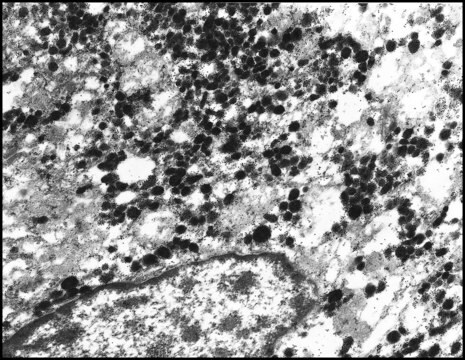G3779
Anti-Rabbit IgG (whole molecule)–Gold antibody produced in goat
affinity isolated antibody, aqueous glycerol suspension, 10 nm (colloidal gold)
Synonym(s):
Goat Anti-Rabbit IgG Antibody
Sign Into View Organizational & Contract Pricing
All Photos(1)
About This Item
Recommended Products
biological source
goat
Quality Level
conjugate
gold conjugate
antibody form
affinity isolated antibody
antibody product type
secondary antibodies
clone
polyclonal
form
aqueous glycerol suspension
particle size
10 nm (colloidal gold)
storage temp.
2-8°C
target post-translational modification
unmodified
Looking for similar products? Visit Product Comparison Guide
Application
Anti-Rabbit IgG (whole molecule)-Gold antibody produced in goat was used as secondary antibody in Pre-embedding Immunogold Electron Microscopy.
Biochem/physiol Actions
IgG antibody subtype is the most abundant serum immunoglobulin of the immune system. It is secreted by B cells and is found in blood and extracellular fluids and provides protection from infections caused by bacteria, fungi and viruses. Maternal IgG is transferred to fetus through the placenta that is vital for immune defense of the neonate against infections.
Other Notes
Antibody adsorbed with human serum proteins.
Physical form
Colloidal suspension in Tris buffered saline, pH 8.2, with 30% glycerol (v/v), 1% bovine serum albumin (w/v), and 15 mM sodium azide.
Disclaimer
Unless otherwise stated in our catalog or other company documentation accompanying the product(s), our products are intended for research use only and are not to be used for any other purpose, which includes but is not limited to, unauthorized commercial uses, in vitro diagnostic uses, ex vivo or in vivo therapeutic uses or any type of consumption or application to humans or animals.
Not finding the right product?
Try our Product Selector Tool.
Storage Class Code
10 - Combustible liquids
WGK
WGK 3
Flash Point(F)
Not applicable
Flash Point(C)
Not applicable
Personal Protective Equipment
dust mask type N95 (US), Eyeshields, Gloves
Choose from one of the most recent versions:
Already Own This Product?
Find documentation for the products that you have recently purchased in the Document Library.
Karl Leitner et al.
Histochemistry and cell biology, 117(2), 187-193 (2002-04-06)
The non-covalent association of beta 2-microglobulin with MHC class I molecules and MHC class I-type molecules such as FcRn or the hemochromatosis protein (HFE) is of major importance for their function, i.e., antigen presentation, IgG transport, and regulation of iron
Ana Ortega et al.
PloS one, 12(9), e0185062-e0185062 (2017-09-22)
Alterations in myocardial structure and reduced cardiomyocyte adhesions have been previously described in dilated cardiomyopathy (DCM). We studied the transcriptome of cell adhesion molecules in these patients and their relationships with left ventricular (LV) function decay. We also visualized the
Neeliyath A Ramakrishnan et al.
The Journal of biological chemistry, 287(45), 37628-37646 (2012-09-06)
A unique coupling between HCN1 and stereociliary tip-link protein protocadherin 15 has been described for a teleost vestibular hair-cell model and mammalian organ of Corti (OC) (Ramakrishnan, N. A., Drescher, M. J., Barretto, R. L., Beisel, K. W., Hatfield, J.
Marguerite K McDonald et al.
Pain, 155(8), 1527-1539 (2014-05-06)
Exosomes, secreted microvesicles transporting microRNAs (miRNAs), mRNAs, and proteins through bodily fluids, facilitate intercellular communication and elicit immune responses. Exosomal contents vary, depending on the source and the physiological conditions of cells, and can provide insights into how cells and
Camilo J Morado-Díaz et al.
The Journal of neuroscience : the official journal of the Society for Neuroscience, 34(20), 7007-7017 (2014-05-16)
Transplants of neural progenitor cells (NPCs) into the injured CNS have been proposed as a powerful tool for brain repair, but, to date, few studies on the physiological response of host neurons have been reported. Therefore, we explored the effects
Our team of scientists has experience in all areas of research including Life Science, Material Science, Chemical Synthesis, Chromatography, Analytical and many others.
Contact Technical Service






